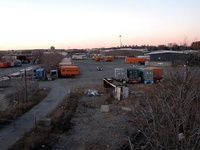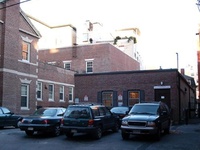
SPH’s brand-new Francois-Xavier Bagnoud building would likely be retained as a link to Longwood even if the school moves to Allston.
When David Canning proposed offering a class in international health economics this spring at the School of Public Health (SPH), he discovered that there was not a single classroom that could hold his class—unless he offered it at 8:30 in the morning.
Canning, who is professor of economics and international health at SPH, was witnessing first-hand the constraints imposed by the outdated, overcrowded complex of Longwood buildings that currently house the school.
His struggle to find a classroom is just the tip of the iceberg for a school that is also exceedingly short on laboratory and office space. SPH is crunched by more than 100,000 square feet, a number that will skyrocket over the coming years, according to Associate Dean for Administration and Operations Paul S. Riccardi.
SPH must currently lease 130,000 of its 700,000 square feet elsewhere, resulting in a scattered campus that includes 14 facilities dispersed all over the Boston area.
Those problems have begun to take their toll. While faculty and administrators alike insist the school’s academic mission has not been compromised, they concede that the crunch is on the verge of becoming a crisis, and have made finding adequate facilities a top priority.
The University’s largely undeveloped campus in Allston holds the promise of desperately-needed space for the cramped school.
University President Lawrence H. Summers announced in October that SPH, the Graduate School of Education (GSE), a science hub and potentially undergraduate housing are the University’s main “planning assumptions” for its campus of the future.
For a school struggling to acquire space, the opportunity to develop a coherent campus in Allston that can expand to meet its substantial growth needs will be hard to turn down.
Indeed, the SPH move is considered the most certain of the “assumptions”—several of which have drawn heavy criticism—and the school would be among the first wave of institutional development in Allston.
But transplanting to Allston is not without downsides for the faculty and students of SPH, many of whom insist that the school is still making its own decisions about a new campus.
Faculty remain profoundly—yet quietly—ambivalent about Allston, citing concerns about estrangement from the school’s historic center in the Longwood Medical Area, the unappealing, undeveloped state of the Allston neighborhood as well as what they call the unilateral process by which the central administration has proceeded with Allston planning.
Despite a marked lack of organized opposition to a move, a faculty-wide survey conducted by consulting firm Payette Associates revealed that the faculty is split nearly 50-50 on whether an Allston move would improve or detract from their professional and personal lives.
The choices facing SPH are more concrete than those facing many of Harvard’s other schools, but still SPH’s situation sheds light on the challenge of making sense of a new campus.
The Space Crunch
SPH’s desperate need for space expands into all facets of the school’s work. Riccardi says the shortage in laboratory space is most severe, constricting the school’s research efforts.
Read more in News
Black Female Alums Celebrate Third Decade














